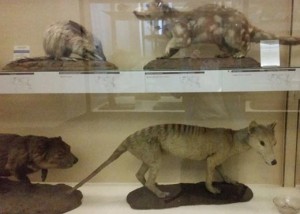Many Native Mammal Species on the Brink of Extinction
A survey on Australia’s native mammal species due to be published this week will reveal that Australia is losing its mammal species at a faster rate than almost anywhere else in the world. Much of the native fauna of Australia is unique and the introduction of cats and foxes is having an dramatic toll on small mammal species. As most of these mammals are shy and nocturnal, people are simply not aware that many species are threatened.
In a scientific report prepared by Charles Darwin University (Northern Territory) the research team state that since 1788, the year of the founding of the first European colony on the continent, 11% of the 273 native, terrestrial mammals had become extinct. The report suggests that 21% are threatened with a further 15% near threatened.
The Thylacine – A Famous Australian Extinction

A Thylacine (bottom right), is included in the Australian mammals part of the gallery (Senckenberg Museum).
Picture credit: Everything Dinosaur
Extinction Rate
Lead author of the study, conservation biologist John Woinarski declared:
“No other country has had such a high rate and number of mammal extinctions over this period, and the number we report for Australia is substantially higher than previous estimates.”
Cats are regarded as the number one problem. Nobody knows for sure how many feral cats there are in Australia, but some estimates put it at around 23 million. That’s one cat for every person in the country. Foxes introduced for hunting, have also had an impact on native wildlife. However, land management and agricultural practices may also be playing a role in the decline of many native species.
Fires either natural or deliberately started are also having a dramatic effect on the small mammal population.
Dr Woinarski explained:
“Now we are seeing much more extensive and hot fires and that’s having an impact as well. It’s not as serious a factor as predation by feral cats, which we think is the number one factor. But the two factors aren’t independent. It seems the impact of feral cats is far worse in extensively burnt areas, simply because many of those native land mammals species don’t have enough refuge left.”
Native Mammals Under Threat
In time, some of Australia’s most famous inhabitants might become extinct, animals like the Koala and many types of Wallaby.
The Charles Darwin University has been prominent in recent years, undertaking a number of significant and highly influential environmental research projects to assess the health of the country’s native flora and fauna. The Brush-Tailed-Rabbit-Rat (Conilurus penicillatus), is one such mammal that has declined in numbers over the years. Its small size and secretive nature has meant that the reduction in population has gone unnoticed by most Australians.
A spokesperson from Everything Dinosaur commented:
“Hopefully, this new study will help to highlight the plight of many of Australia’s shy, nocturnal small mammals. Tough choices may have to be made with regards to controlling feral cat populations and reducing the number of foxes if the decline in native species is to be halted.”
The Cane Toad
Intriguingly, Everything Dinosaur team members are not aware of any mention of the Cane Toad (Rhinella marina) and this amphibians impact on native mammal populations. Introduced from Hawaii in the mid 1930s, the Cane Toad is poisonous and has no natural enemies in Australia. The Cane Toads not only compete for food and resources with native species, but they also eat large numbers of insects, including pollinators, frogs, small lizards and occasionally small mammals. As these animals are poisonous throughout their life cycle, many Australian species have declined as a result of being poisoned the Western Quoll (Dasyurus geoffroii) is particularly threatened.
Visit Everything Dinosaur’s award-winning website: Everything Dinosaur.






Leave A Comment